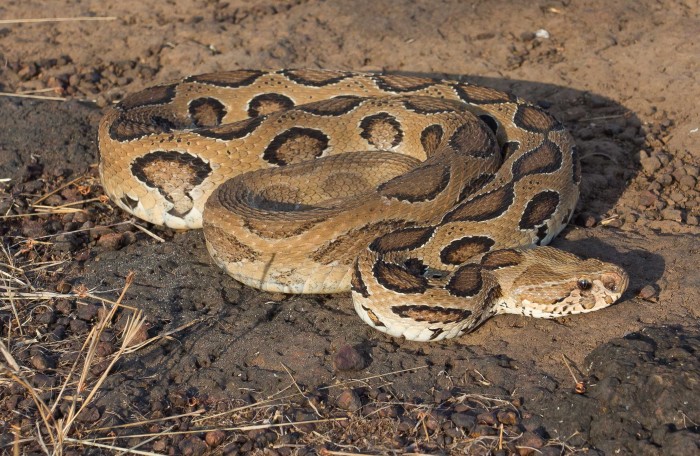Many people get terrified by just hearing the word Snake. They produce deep fear in people as compared to any other animal.
Here is a list of the top 10 Deadliest Snakes in the World.
Table of Contents
#10. Green Mamba

Green Mambas are highly venomous and deadly snakes. There are three types of Green Mamba snakes – Eastern, Western and Jameson’s. All these types are very aggressive and one of the most deadliest snakes in the world. They can in no time go from a very calm state to an extremely agitated and dangerous state.
All these three species of Green Mamba snakes are arboreal. These are very agile and exceptionally fast. They also tend to strike repeatedly when irritated even though they are much less aggressive than their larger cousin, the Black mamba.
Western Green Mamba
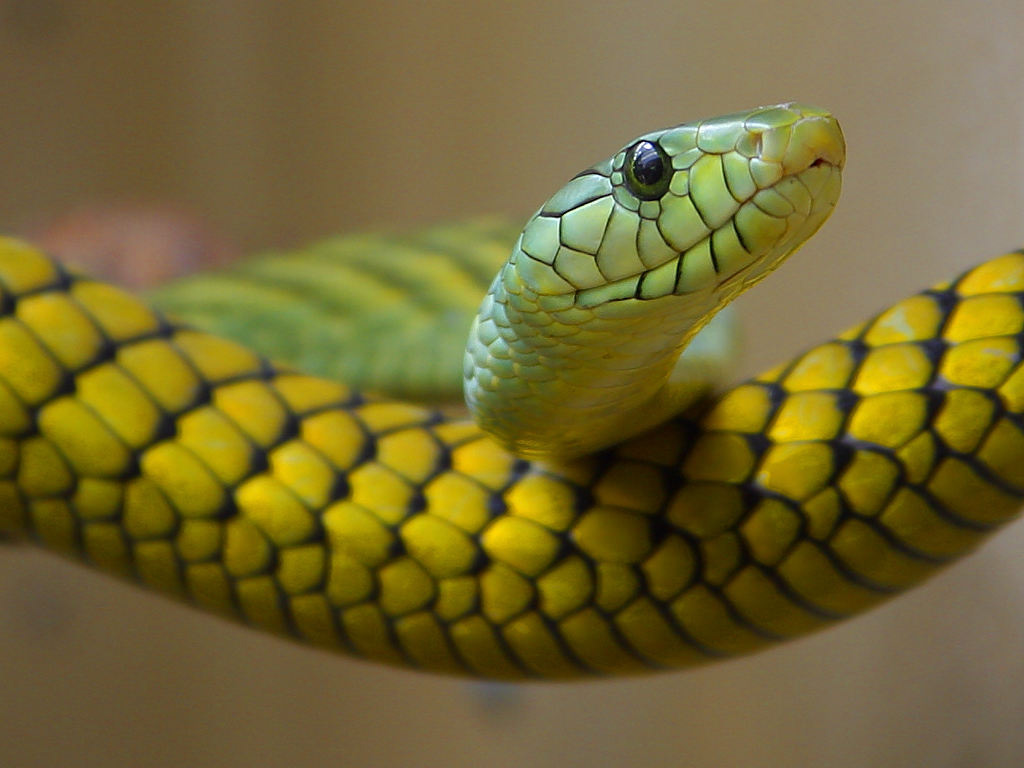
The western green mamba also known as the West African green mamba or Hallowell’s green mamba, is a long, thin, and highly venomous snake of the mamba genus. The Western green mamba lives mainly in the coastal tropical rainforest, thicket, and woodland regions of western Africa.
They have a very potent venom with an LD50 of 0.7 mg/kg subcutaneous injection. The average venom yield per bite is approximately 100 mg. The mortality rate of untreated bites is unknown but is thought to be very high (>80%).
Eastern Green Mamba
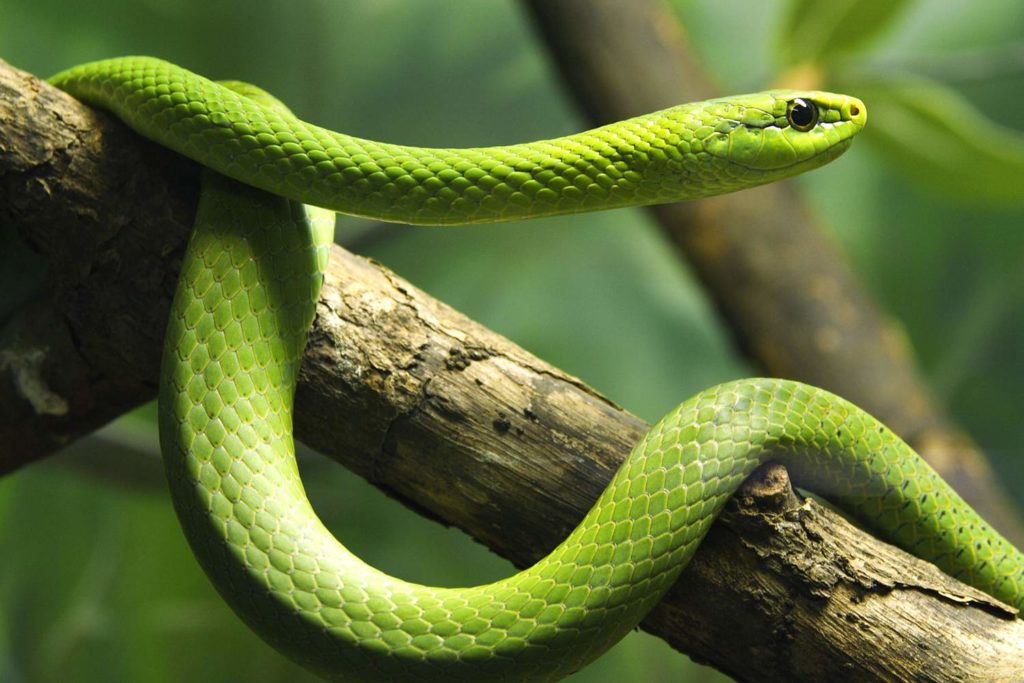
The eastern green mamba is found in the coastal regions of southern and eastern Africa. Their range extends from south of Kenya to Tanzania, Malawi, eastern Zimbabwe, and eastern Zambia. They are also present in Zanzibar, northern Mozambique and the northeastern part of Eastern Cape along the KwaZulu-Natal coastline in South Africa.
The eastern green mamba is a large snake with a slender body. On average males are slightly shorter than females. The average length of an adult female is 6.6 feet and the adult male is 5.9 feet.
Their venom is primarily neurotoxic and contains a complex mix of dendrotoxins, calcicludine, cardiotoxins, and fasciculins. The subcutaneous LD50 for this species ranges from 0.40 mg/kg to 3.05 mg/kg. The mortality rate of untreated bites is unknown but is thought to be very high (70-75%).
The symptoms of eastern green mamba include swelling of the bite site, dizziness, nausea, irregular heartbeat, convulsions and difficulty breathing and swallowing. All of this may lead to respiratory paralysis.
Jameson’s Mamba
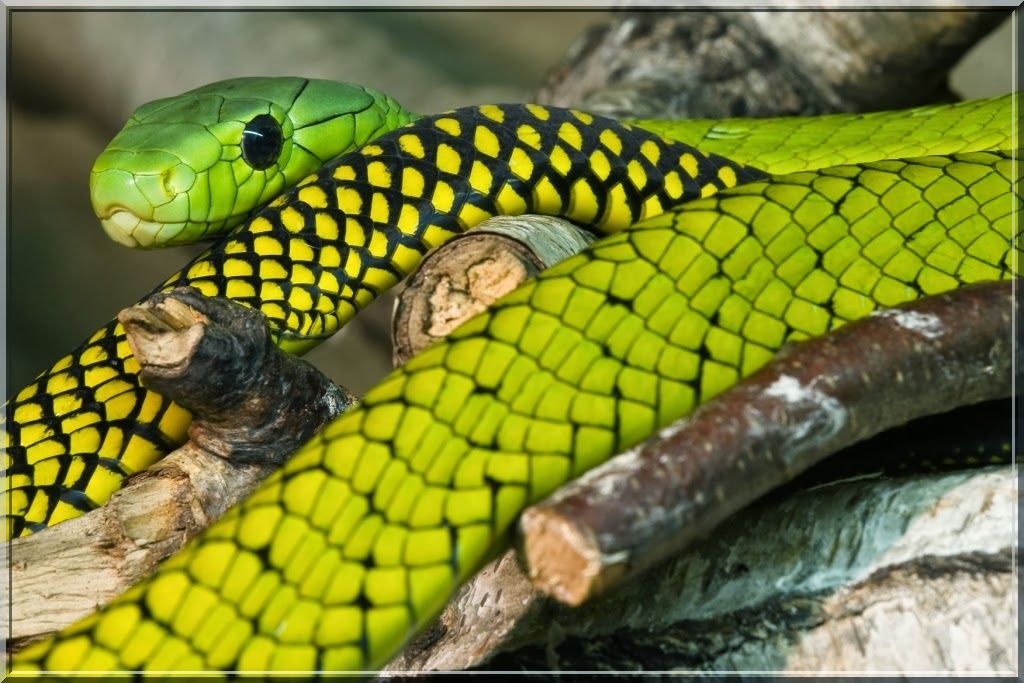
The Jameson’s Mamba is found in primary and secondary rainforests, woodland, and forest savanna. Their range extends throughout central and west Africa. The Jameson’s mamba is an adaptable species and is found in areas where there has been extensive deforestation and human development.
They are more arboreal snakes as compared to their close relatives the eastern green mamba, western green mamba, and the black mamba. Jameson’s Mamba is again a large snake with a slender body like the other mambas—their average length ranges between 4.9 feet to 7.2 feet.
The Jameson’s mamba bite can be deadly and if untreated victim will die in as little as 30 to 120 minutes. The average venom yield per bite for this species is 80 mg and in some cases, it may be as high as 120 mg in a single bite. The mortality rate of untreated bites is not known exactly, but it’s said to be very high and almost more than 80%.
#9. Tiger Snake
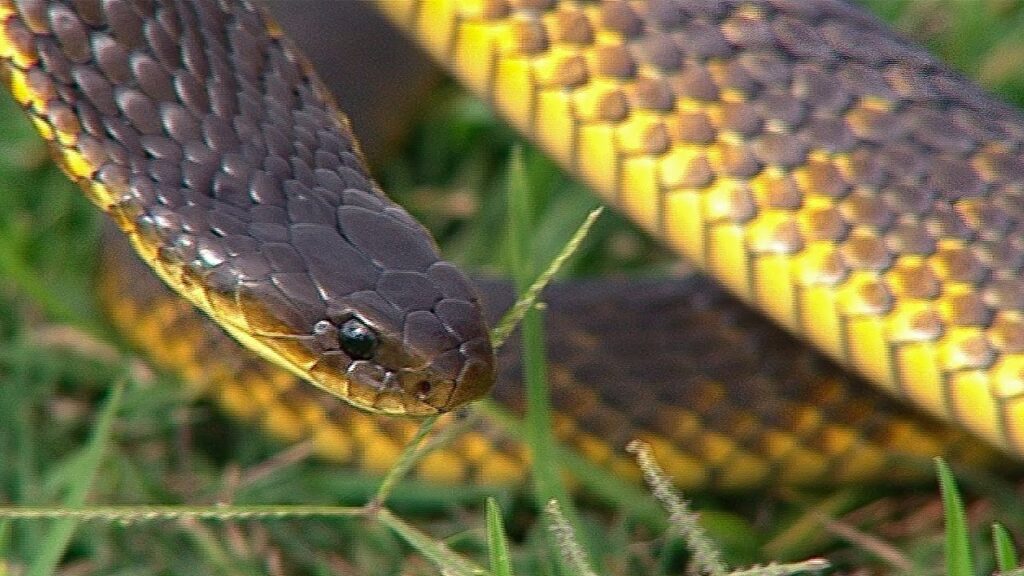
Australia is home to many deadly and venomous snakes. Tiger snake is one of them and is a highly venomous snake species found in the southern regions of Australia, including its coastal islands.
Tiger snakes are very aggressive and have a fearsome reputation. Tiger snakes come in many colours, in addition to the yellow and black bands that gave them their name. Tiger snakes can also be greenish-black or brownish-black with lighter yellow or cream-coloured bands, or solid colours with no bands like brownish-yellow or all-black.
Tiger snake venoms possess potent neurotoxins, coagulants, haemolysins, and mycotoxins. Death from a bite can occur within 30 minutes but usually takes 6-24 hours. Before the development of antivenin, the fatality rate from Tiger snakes was 60-70%.
Symptoms of a bite include localized pain in the foot and neck region, tingling, numbness, and sweating, followed by a fairly rapid onset of breathing difficulties and paralysis.
The Tiger snake will generally flee if encountered, but can become aggressive when cornered and will strike with flawless accuracy.
Read More: Top 10 Amazing Facts About Snakes
#8. Common Death Adder
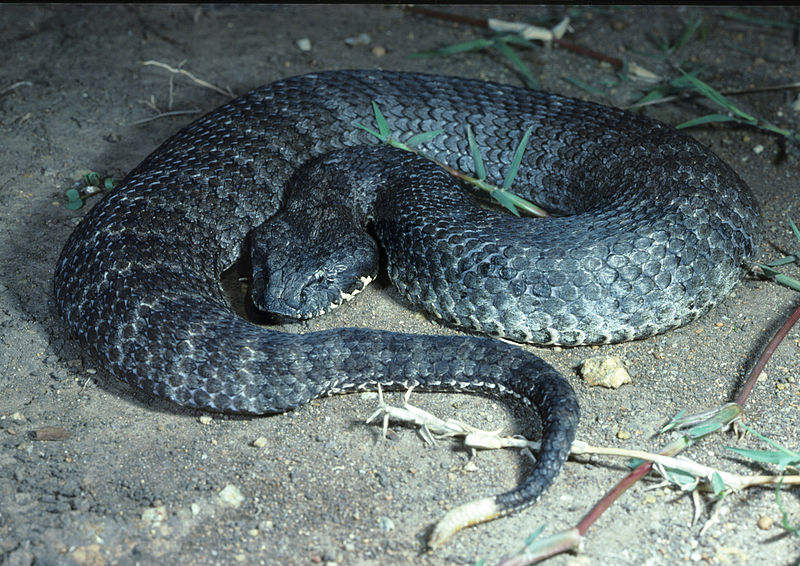
Death Adder is a highly venomous snake and is found in Australia and New Guinea, including offshore islands. Death Adder is one of the most venomous snakes in the world and also has the fastest strike rate among other snakes.
The death adders have a very similar appearance to vipers or pit vipers. They have short and robust bodies, narrow necks, triangular-shaped heads and a tail spine. They also possess the longest fangs of any Australian snake.
Death adders are mainly nocturnal. Unlike other snakes, they don’t actively hunt. The death adder buries itself in soil, leaves or sand, leaving only the head and tail exposed, but still very well camouflaged and uses the end of its tail for caudal luring to attract the prey. They wait for several days for the victim to pass by.
Death Adders are the biggest threat to humans because of their ambush-hunting tactics and camouflage. It can go from a neutral position to a strike and back in just 0.13 seconds.
Their venom is a neurotoxin. The death adder bite causes paralysis and can cause the death of the victim within 6 hours, due to respiratory failure. Symptoms generally peak within 24-48 hours. Each bite of death adder injects around 40-100mg of venom with an LD of 0.4mg-0.5mg/kg.
Untreated human cases of a death adder bite have a 50% fatality rate. But antivenin is extremely successful in treating these deadly bites because of the relatively slow progression of the symptoms
Read More: Top 10 Astonishing Facts about King Cobra
#7. Eastern Brown Snake
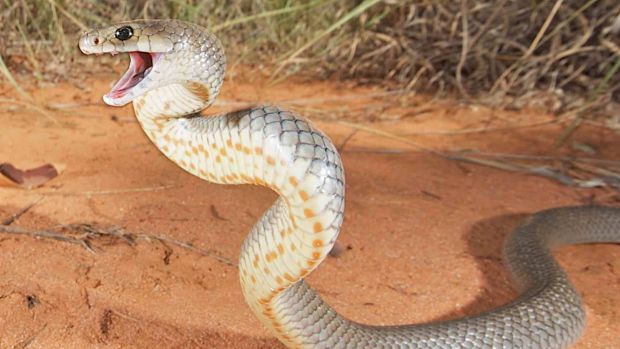
An Eastern brown snake is the second most venomous land snake in the world. They are native to eastern and central Australia and southern New Guinea. Brown snakes are sometimes referred to as “city snakes” because they thrive in residential areas.
An Eastern brown snake has variable upper parts that can be several shades of brown, ranging from pale brown to almost black, while its underside is pale cream-yellow, often with orange or grey splotches.
The eastern brown snake is up to 7 feet long with a slender build and its fangs are small compared to those of other Australian venomous snakes. They are fast-moving and are aggressive. Even a juvenile can kill a human.
The eastern brown snake’s venom is neurotoxic and has blood coagulants. They are responsible for more deaths every year in Australia than any other group of snakes.
Symptoms can be rapid, with a headache developing in 15 minutes and clotting abnormalities within 30 minutes; collapse has been recorded as occurring as little as two minutes after being bitten.
#6. Blue Krait
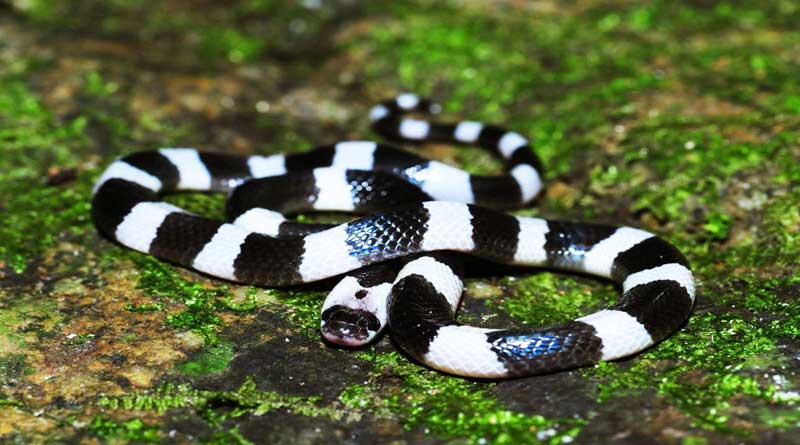
The Blue Krait also known as the Malayan Krait is a highly venomous snake species native to Southeast Asia. The Blue Krait is found in Peninsular Malaysia, central Vietnam, Thailand, Bali, Lao People’s Democratic Republic, Indonesia, Singapore, and Sumatra.
The blue Krait is probably the most venomous snake found in Asia and it ranks among the deadliest snakes in the world. These snakes are nocturnal and very aggressive in the night.
The average length of Blue Kraits is about 3.5 feet but the maximum length may reach up to 5.25 feet.
Blue kraits are an Ophiophagus species, meaning that they feed on other snakes even those of their kind. They also eat lizards, mice and other small animals. Blue Kraits are active hunters and move around at night in search of prey.
50% of bites from the deadly Blue Krait are fatal, even with the administration of antivenin.
The blue Kraits are not very aggressive and are quite timid. They will often attempt to hide rather than fight.
The venom of Blue Krait is a neurotoxin; the LD50 value in mice is 0.1 mg/kg, which means that their venom is 15 times more toxic than that of a common cobra.
The symptoms of the bite are loss of nerve function, muscle paralysis, cramps, tremors and muscle spasms this all leads to paralysis.
Before the development of antivenin, the fatality rate was 85%. Even if antivenin is administered on time, survival is not assured.
Death usually occurs within 6-12 hours of a Krait bite.
#5. The King Cobra

The King Cobra is the longest venomous snake. Besides its toxic venom, the king cobra’s size is enough to frighten anyone. A mature king is the longest venomous snake on the entire planet. They can grow up to 5.7 meters (18.8 feet) long; with males being longer and thicker than females.
It is believed that the King Cobra, like other Cobras, belong to the Naga genus but the King Cobra has its genus called Ophiophagus which means snake eating in Greek.
The King Cobra is one of the most deadliest snakes in the world. They are native to India and can be found in the major parts of the country, especially the east and northeast parts. This marvellous snake can also be found in the neighbouring countries of Nepal, a few parts of China, Thailand and Indonesia, the Philippines and Vietnam.
King Cobras live in the highland dense forest and are commonly found around water bodies like streams and lakes. However, the population of King Cobras has declined due to the destruction of forests.
Though King Cobras have a frightening reputation, generally, they are very shy and avoid confrontation as much as possible. When confronted they will try to escape. But the nesting female is an exception and can attack very readily.
King Cobras venom is neurotoxic and can kill an elephant in a matter of just some hours. It can release enough poison to kill 20 grown men in a single bite. The venom is so deadly that it can kill a human in close to 25 minutes. It attacks the brain and respiratory system and death occurs due to respiratory and cardiac failure.
#4. Fer-de-lance
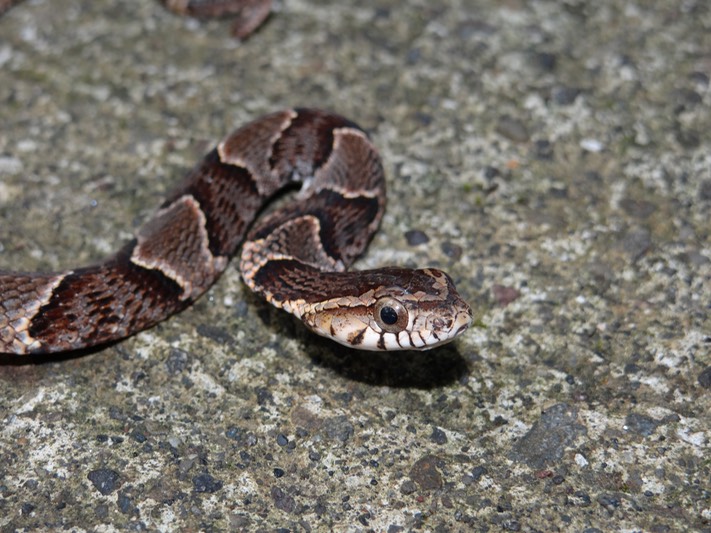
The fer-de-lance is also called terciopelo and is also known by many local names. It is a highly venomous pit viper.
They are found in Southern Mexico and Central American countries including Guatemala, Honduras, Belize, Nicaragua, Panama and Costa Rica. It is also found in the northern regions of South America, including Ecuador, Colombia, and Venezuela.
The average length of the fer-de-lance measures between 4 to 6 feet and may weigh up to 13 pounds (6 kg). Females are much larger than males and have thicker and heavy bodies sometimes reaching up to 10 times the size of males.
The average length of the fer-de-lance measures between 4 to 6 feet and may weigh up to 13 pounds (6 kg). Females are much larger than males and have thicker and heavy bodies sometimes reaching up to 10 times the size of males.
The fer-de-lance has a very lethal potent and fast-acting hemotoxic venom. They are the main cause of snakebite incidents within its range and bite symptoms include local pain, severe swelling, numbness, nausea, vomiting, blistering, bruising, and necrosis.
They are considered the most dangerous snake species in Costa Rica, responsible for almost half of all snakebites. Many people are killed each year within its range by the fer-de-lance.
However, even with its high venom yield and huge fangs, the species have a low mortality rate of around 1 to 2%, as the specific anti-venom is quite effective. But, in many cases, the tissue necrosis is quite severe and amputations are very common, those bitten end up losing limbs or parts of the extremities.
Read More: Top 10 Amazing Facts about Cats
#3. The Big Four
The Big Four are the four venomous snake species responsible for causing the most snakebite cases in South Asia mostly in India. These snakes are very abundant in these countries in highly populated areas, so they are responsible for most snakebites and deaths. They are the Indian cobra, Common Krait, Russell’s viper and the Saw-scaled viper. These four snakes are among the deadliest snakes in the world.
Indian Cobra
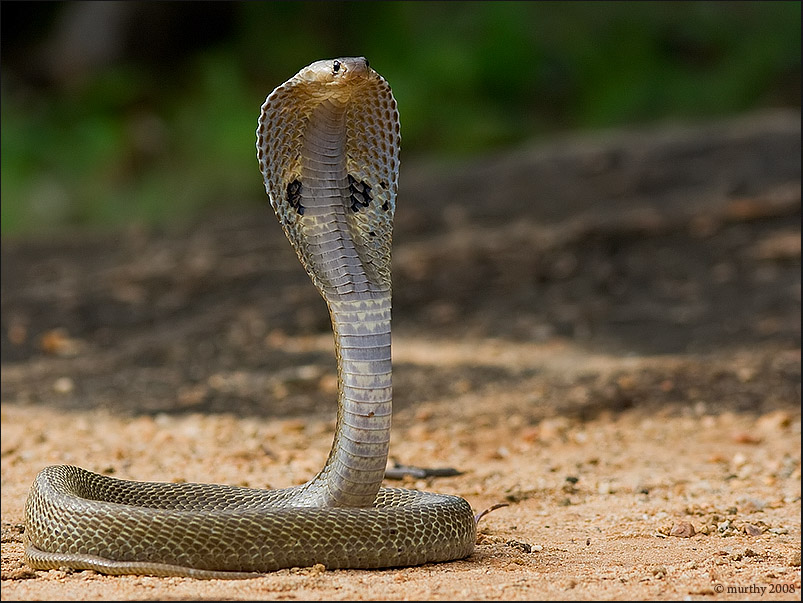
The Indian cobra is also known as the spectacled cobra, Asian cobra, or binucleate cobra. The Indian cobra is a moderately sized but heavy-bodied species. They can easily be identified by its relatively large and quite impressive hood, which it expands when threatened.
The Indian cobra is native to the Indian subcontinent and can be found throughout India, Pakistan, Sri Lanka, Bangladesh, and southern parts of Nepal. It occurs in dense or open forests, plains, rocky terrain, and wetlands. It can also be found in rice paddy fields, heavily populated areas like villages and city outskirts.
The Indian Cobra has an average length of 3.3 to 4.9 feet. Some cobras, particularly those from Sri Lanka, may grow to lengths of 6.9 to 7.2 feet, but this is relatively uncommon.
The Indian cobra is responsible for many human fatalities by snakebite in India. The Indian cobra venom is highly neurotoxic. It contains powerful post-synaptic neurotoxins and cardiotoxins.
The symptoms include swelling in the bite area, weakening of limbs, eyelid drooping and extreme salivation. The victim experiences vomiting and sweating followed by paralyzing muscles. In case of severe bites, it can lead to respiratory failure or cardiac arrest and ultimately to death.
The subcutaneous LD50 value in mice, ranges from 0.45 mg/kg to 0.75 mg/kg, with an average venom yield per bite ranging between 170 and 250 mg.
Even though Indian cobras are responsible for thousands of bites but if proper medical attention and anti-venom are given, only about 10% of bites prove to be fatal. The mortality rate for untreated bite victims is around 15–20%. They are responsible for 15000 deaths annually and an estimated 100,000-150,000 non-fatal bites per year.
The Common Krait
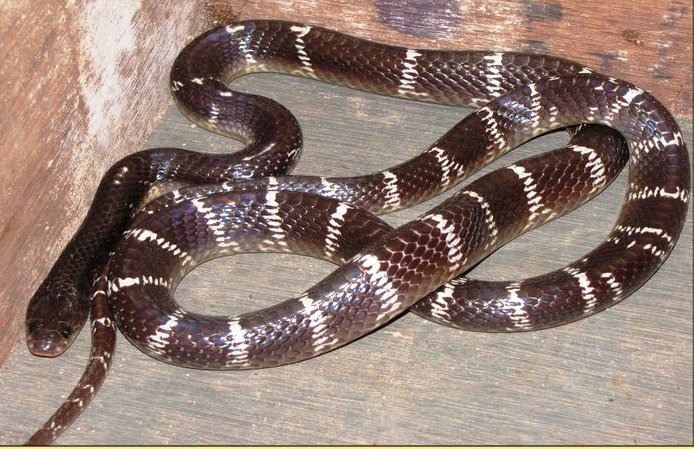
The Common Krait is also known as the Indian krait and is a highly venomous and one of the deadliest snakes found in the Indian subcontinent. They are found in Peninsular India, West Bengal plains and throughout southern India. They are also found in Sri Lanka, Nepal, Bangladesh, Pakistan and Afghanistan.
They are found in a variety of habitats Generally, the common krait inhabits fields and low scrub jungles, they can also be found in termite mounds and rat holes. It is frequently found in water or near a source of water.
The Common Krait is an exclusively nocturnal species that is active only from late evening to the early morning during the day they mostly remain inactive, but during the night they become very active and aggressive.
The Common Krait is a moderately slender medium-sized snake with an average length of around 3 feet but it can grow to a maximum length of 6 feet.
The Common Krait has the most potent snake venom amongst the big four and it is regarded as one of the most toxic in the world. It is responsible for the second-most snake bites in India with an estimated 10,000 fatalities per year. In Bangladesh, it’s responsible for 28% of total Krait bites.
Although they bite very occasionally when disturbed, when they do, they typically hold on to the victim for a while, which enables them to inject considerable amounts of venom.
The average venom yield per bite of 10 mg in dry weight with the LD50 values of its venom is 0.325 mg/kg subcutaneously in mice.
The symptoms include severe abdominal cramps, tightening of the facial muscles and inability to see or talk combined with progressive paralysis. Death occurs due to respiratory failure.
An untreated Common Krait bite has a mortality rate of 70 to 80%, and death can occur in as little as four to eight hours after the bite.
Russell’s Viper
The Russell’s viper is a venomous old-world viper. It is found throughout Asia, in the Indian subcontinent, much of Southeast Asia in southern parts of China and Taiwan.
The Russell Viper is leaner than most other vipers and has an average length of about 4 feet on mainland Asian populations. Island populations may be slightly smaller on average. They can grow to a maximum length of 5.5 feet.
The Russell Vipers are terrestrial and primarily nocturnal, especially during hot weather. However, during cool weather, they tend to change their behaviour and become more active during the day.
The quantity of venom produced by Russell’s viper is considerable, with adult specimens injecting from 130 mg to 268 mg in a single bite. The Russell’s viper is responsible for more human fatalities in India than any other snake species, causing an estimated 25,000 fatalities annually.
They produce one of the most unbearable painful bites of all venomous snakes and other symptoms including blistering and swelling at the bite, bleeding (especially from the gums), vomiting, dizziness, blood in-coagulability and kidney failure.
The Saw-Scaled Viper
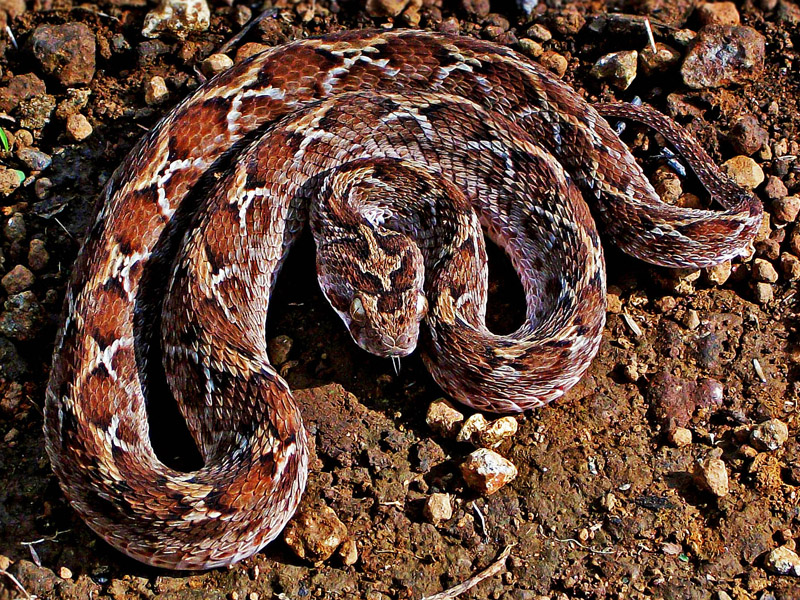
The Saw-scaled viper is also called the carpet viper. These are very aggressive and unpredictable snakes. Their venom is very potent and is one of the fastest striking snakes in the world.
The Saw-scaled vipers are relatively small snakes, the largest species are usually below 90 cm long, and the smallest is around 30 cm.
They are found in India, Pakistan, Sri Lanka, parts of the Middle East and Africa. In drier regions of the African continent, such as the Sahel and savannas, the saw-scaled vipers inflict up to 90% of all bites. In India alone, the saw-scaled viper is responsible for an estimated 5,000 human fatalities annually.
They may inject venom in a single bite as much as 12 mg, whereas the lethal dose for an adult human is estimated to be only 5 mg. The local symptoms include swelling and intense pain, which appear within minutes of a bite. In severe cases, the swelling may extend up to the entire limb within 12–24 hours and blisters form on the skin.
Read More: Top 10 Most Intelligent Dog Breeds
#2. Coastal Taipan
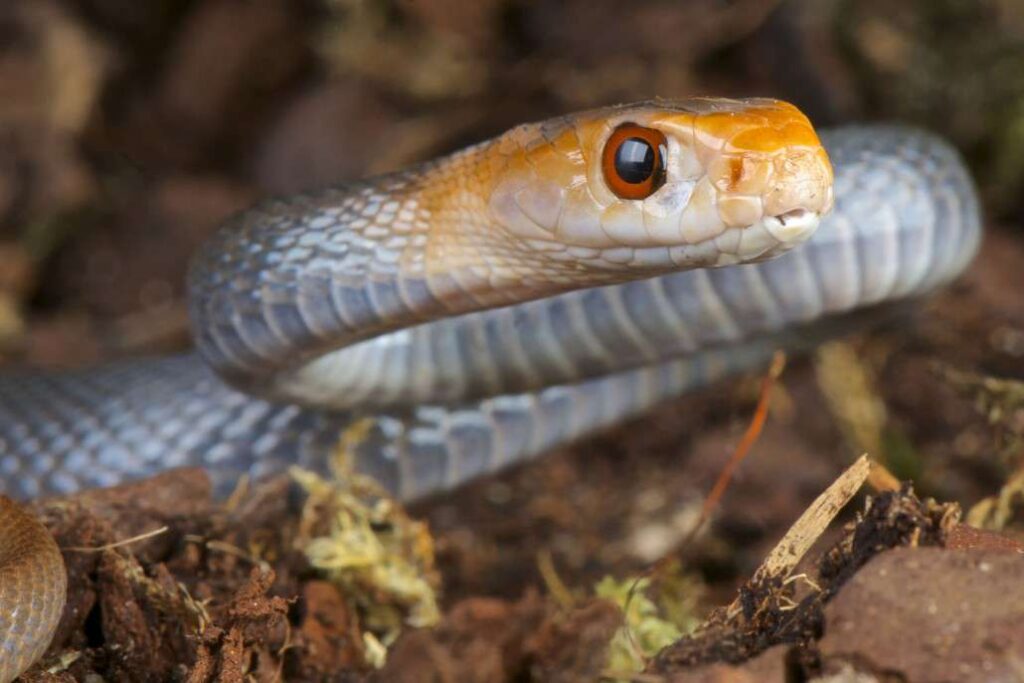
The Taipan is a large, fast-moving and highly venomous snake that is found in Australia. The Taipan currently has three recognised species, Inland Taipan, Coastal Taipan, and Central Ranges Taipan. The Coastal Taipan has two more subspecies.
Taipan possesses highly neurotoxic venom with some other toxic constituents that have multiple effects on victims.
The venom is known to paralyse the victim’s nervous system and clot the blood, which then blocks blood vessels. Most people die within just one hour of a bite. Before the advent of antivenin, there were no known survivors of a Taipan bite.
#1. Black Mamba
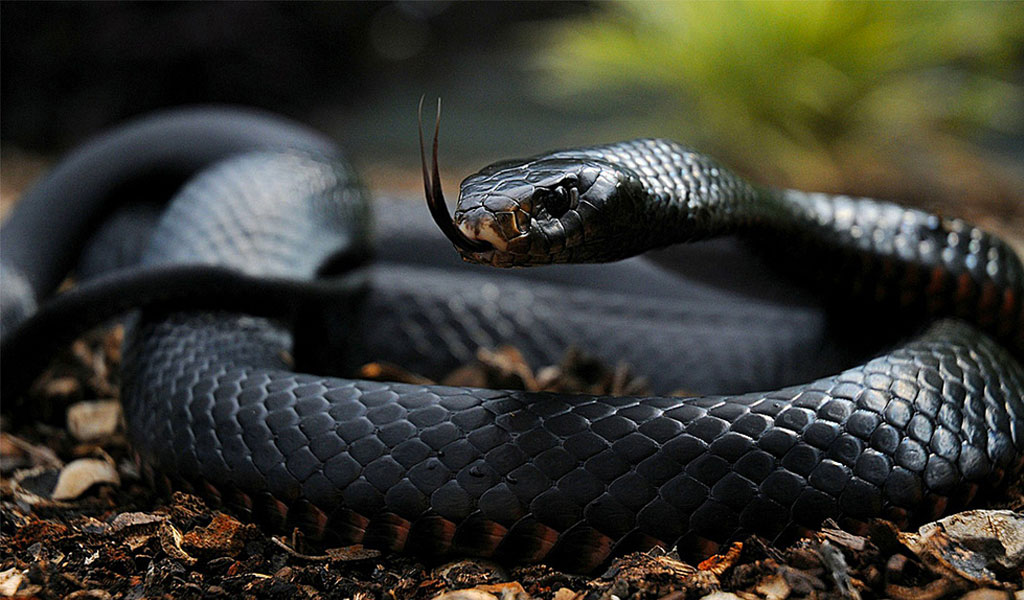
Black mambas live in the savannas and rocky hills of southern and eastern Africa. They are Africa’s longest venomous snakes and are also among the fastest snakes in the world.
Black mambas are shy snakes and will always try to escape when confronted, but if cornered, these snakes will raise their heads, sometimes with a third of their body off the ground, spread their cobra-like neck-flap, open their black mouths, and hiss enough to frighten anyone.
The average length of the Black mambas is 8.2 feet but some can grow up to 14 feet in length. Black mambas are capable of reaching speeds of up to 20km/h. A single bite can kill anywhere from 10-25 adults and they can strike 12 times in a row.
The venom of black mambas is a neurotoxin. In a single bite, it can deliver up to 400mg of venom. Before the advent of black mamba antivenin, a bite from this deadly snake was 100 per cent fatal, usually within about 20 minutes.
The initial symptoms of the bite may be a tingling sensation in the area of the bite, tunnel vision, double vision, foaming of the mouth or nose, loss of muscle control, and confusion. If proper medical attention is not given, symptoms rapidly progress to severe abdominal pain, nausea, vomiting, cardiotoxicity and paralysis. Eventually, the victim experiences convulsions, respiratory arrest, coma and then death.

